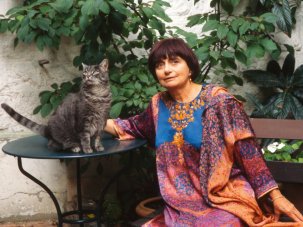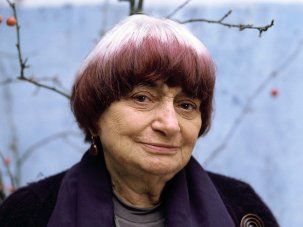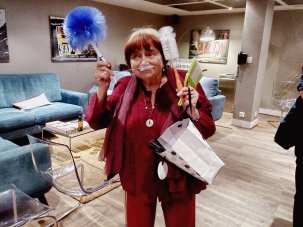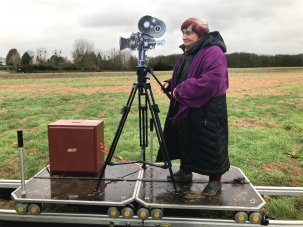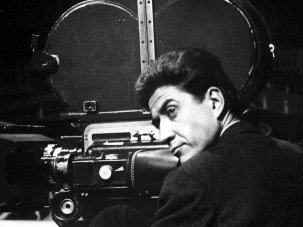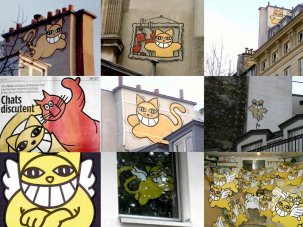from our July 2018 issue
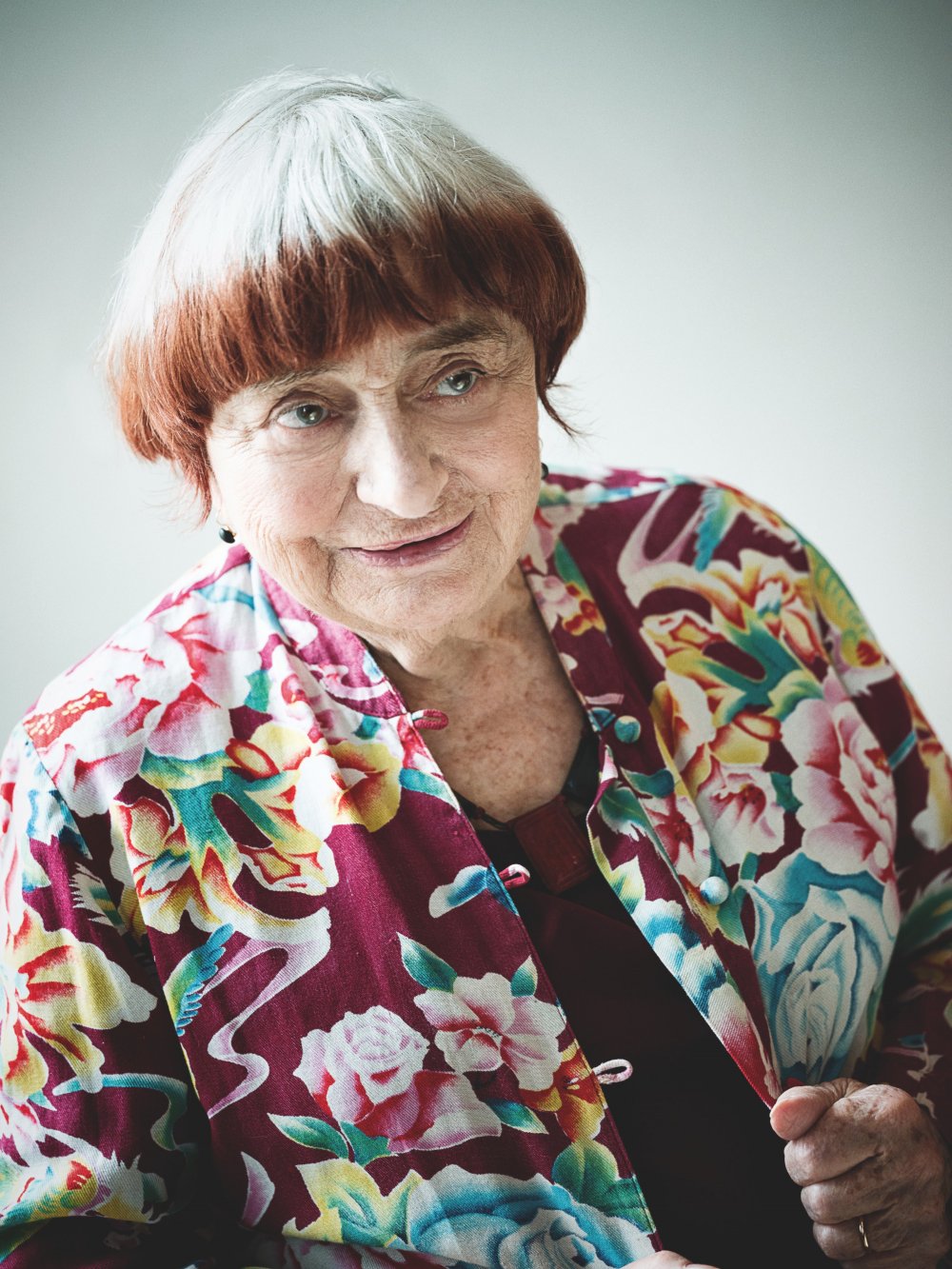
Agnès Varda
Credit: Yves Salmon/Getty Images
For someone whose artistic lifetime of more than six decades was spent contentedly occupying the position, as she put it herself in an interview with Kiva Reardon [excerpted in our January/February 2019 issue], of a “princess” of the “margins” of film culture, the past year has seen 90-year-old Agnès Varda enjoying a more mainstream visibility. Perhaps the times finally caught up with her work, both aesthetically – with her long-held disregard for supposed artistic and cinematic boundaries and categories chiming with our new more porous film culture – and politically and socially, for Varda was a touchstone figure for many in the debates swirling around film culture in the wake of the #MeToo movement and the long overdue heralding of the work of female filmmakers from earlier generations.
Defying her age, Varda seemed as busy as ever. 2017’s Cannes saw the premiere of Faces Places, a collaboration with her artistic “comrade”, French artist and photographer JR. Across 2017-18 Varda received an honorary Academy Award, was elevated to the status of a grand officier de la Légion d’honneur, had her work presented in a major retrospective at TIFF in Canada, gave two lectures at Harvard University, and just last month walked the red carpet at this year’s Cannes beside Cate Blanchett, as one of 82 women protesting in solidarity against discrimination in the film industry. Her front and centre position in that protest was a recognition of her status as a veteran pioneer of intensely personal filmmaking that has made her an inspiration to so many.
In the UK last summer, Varda’s films played in in London, with a tour of eight features playing at cinemas across the UK from late July. And in recognition of her achievement as an artist beyond the cinema, she was commissioned to make a new installation artwork by the Liverpool Biennial, which also screened her 1982 short Ulysse, while a film season played at Liverpool’s FACT gallery.
Agnès Varda on the highlights of her career
If Varda enjoyed operating in the marginal space she carved for herself, she never adopted a stance of wilful obscurity. As shows, her approach to her life and to her work was always defined by generous inclusivity. We were welcomed in to her thoughts and fears, to the lives of her children and relatives, to her home and her quirks. There was always, in her work, a warm, genuinely inquisitive interest in the people she met and the stories they had to tell, whether they ewre real figures in her documentaries or characters in her fiction.
From the beginning of her film career, when she was first off the blocks among the loose group of filmmakers who would come to constitute the French New Wave, Varda always followed her own self-invented path. She made her 1954 feature La Pointe Courte despite having no prior filmmaking experience and, by her own admission, without the obsessive cinephilia of Godard, Truffaut and the other ‘Right Bank’ group whom Varda and her ‘Left Bank’ group – Alain Resnais, Chris Marker and her future husband Jacques Demy – stood together with but apart from. Where others saw boundaries, or were more obviously channelled by filmic influences, Varda brought a more idiosyncratic pool of inspirations to her work – such as her experience in still life and documentary photography, felt so keenly in 60s features such as Cléo from 5 to 7 (1962) and Le Bonheur (1965).
That openness surely fed into Varda’s willingness to move between fictional and nonfictional styles – something obvious as early as La Pointe Courte, with its observational sense of place and time, and on documentaries such as L’Opéra-Mouffe (1958). That open curiosity also naturally led her to embrace the joys of travel – as when in 1967 she left France with Demy for California, where she made a series of films (including one on the Black Panthers). Again, it feels entirely in keeping that she should have been out of step with many of the other New Wavers, back in France for May 1968 and fired by the political radicalism of the day.
Black Panthers trailer
That’s not to say that Varda was not a political filmmaker. Returning to France in the early 1970s, she was invigorated by the second wave of feminism. Though she was less prolific during that decade, when she was raising her children, the rallying cry of the feminist movement that ‘the personal is political’ never feels truer than in her work of that time. Take One Sings, the Other Doesn’t (1977), which parallels the contrasting lives of two former friends, Pauline and Suzanne, along separate paths, or her 1975 documentary Daguérreotypes, about the people who live and work on rue Daguerre, the Paris street where Varda has lived since 1951.
She was also one of the great character portraitists, especially of women. Think of Cléo finding her sense of self in Paris or the unforgettable young Sandrine Bonnaire as Mona Bergeron in Vagabond (1985), and films about those close to her – such as Jane B. par Agnes V. (1987), about Jane Birkin, and the beautifully true and warm tribute to her late husband Jacquot de Nantes (1991).
The new century saw Varda embrace the possibilities of new digital technology but using it entirely in keeping with her approach all along. In the pieces that follow, our contributors consider some of the abiding themes that characterise Varda’s work.
Pioneer of the New Wave
by Ginette Vincendeau
La Pointe Courte trailer
In 1954, after studying philosophy and art in Paris and working as a photographer, the 25-year-old Agnès Varda decided to make a film set in La Pointe Courte, a neighbourhood in Sète on the western Mediterranean coast. A simple story: a young Parisian couple, played by stage actors Silvia Monfort and Philippe Noiret, spend a few days in the area, where the husband grew up, deciding whether to stay together or not.
Varda knew Sète well, having lived there as an adolescent during the German occupation, and she embeds the sometimes cryptic discussions of the central couple in the life of La Pointe Courte and its community of fishermen. The result is astonishing in its beauty, social commentary and modernity. How could a young woman with no formal training and, according to her, no knowledge of cinema history, produce a groundbreaking film that, in the words of historian Georges Sadoul, was “truly the first film of the New Wave”.
Beyond its autobiographical aspect and meshing of documentary and fiction, La Pointe Courte anticipated the New Wave in its production methods. Varda’s own tiny company Ciné-Tamaris, which still exists, produced the black-and-white movie completely outside the mainstream film industry and on a budget one-tenth that of the average French film.
Just as importantly, Varda’s authorial control over scriptwriting and directing, for which she coined the term cinécriture (cine-writing), the exclusive use of location shooting, the combination of professional and non-professional actors – all this was innovative in France in the mid-1950s, and foreshadowed the methods and aesthetics of Claude Chabrol, François Truffaut and Jean-Luc Godard. La Pointe Courte’s complex modernist narrative construction, borrowed from William Faulkner’s 1939 novel The Wild Palms, also anticipated a more ‘intellectual’ type of New Wave cinema, in particular that of Alain Resnais, not coincidentally her editor on the film.
Cléo from 5 to 7 trailer
Varda’s role as pioneer (as opposed to the patronising ‘mother’ or ‘grandmother’ label with which she is often tagged) of the New Wave was unjustly ignored both at the time and for decades afterwards, as attention focused on the male ‘Young Turks’. Yet Cléo from 5 to 7 (1962), her return to fiction film after several documentaries, spectacularly combined the New Wave methods she had pioneered and a unique feminist gaze. The film – produced, scripted and directed by Varda – follows singer Cléo (Corinne Marchand) over a couple of hours during which she anxiously awaits the results of a medical test and simultaneously reassesses her life and relationships.
Shot in black and white (with an opening sequence in colour) on location in Paris in June and July 1961, Cléo from 5 to 7 ranks as one of the greatest city films, while also offering a profound reflection on the construction of female identity. Varda places her examination of female creativity, romance and friendship in a dense network of references to contemporary French culture and society, notably (and unusually) the Algerian War. But she also pays generous tribute to her New Wave colleagues in a humorous film-within-the-film, which features among others Jean-Luc Godard and Anna Karina.
Varda was for too long relegated to a marginal role in the history of the New Wave, treated as an adjunct to her famous colleagues in the more socially and politically aware ‘Left Bank’ strand of the New Wave, which included her husband Jacques Demy, Alain Resnais and Chris Marker. It took the work of feminist historians, notably Sandy Flitterman-Lewis in the 1990s, to reinstate her at the heart of the New Wave and of post-war French cinema.
The (self)portraitist
by Catherine Wheatley
L’Opera Mouffe trailer
Agnès Varda has for a long time been interested in self-portraiture, not only in film form but literary and photographic form too. Her 1994 book Varda par Agnès is as complicated and personal in structure as her films, while early experiments in self-portraiture, such as Autoportrait devant une peinture de Gentile Bellini (1962), hint at an early fascination with finding the self in images of others.
“It should be like I’m taking your hand, taking you through the film,” she told Sight & Sound in 2015. “I’m not really telling a story, I’m telling you what cinema is in my life.” Thus Varda’s experiences of pregnancy inform her short film L’Opéra-Mouffe (1958), made while she was expecting her first child, Rosalie, and One Sings, the Other Doesn’t (1977), which investigates the possible implications of pregnancy from a variety of angles, incorporating fiction, documentary and autobiography.
Motherhood, meanwhile, literally shapes Daguerréotypes – made in 1974-75 while Varda was caring for her two-year-old son Mathieu and unwilling to undertake a film which demanded long periods away from him. Among other things a study of the restricted range of a working mother, the film’s range is confined within a 90m radius of Varda’s home: the length of the electric cables for her equipment.
Varda’s presence is made more explicit in the frequent appearances she and her family make in her films. Daguerréotypes and L’Opéra-Mouffe feature glimpses of Varda, whose presence is also foregrounded by her narration. (Her voiceovers imply her presence in other docs, too, such as Mur Murs, 1981.) Rosalie pops up in several films; Mathieu – a professional actor – stars in works such Kung-Fu Master! (1988), in which he plays the leading role alongside Jane Birkin, and Documenteur (1981), a barely fictionalised account of Varda’s temporary split from filmmaker husband Jacques Demy. Even her cat, Zgougou, has a featuring role in Varda’s cinematic universe, as the mascot of her production company Ciné-Tamaris.
Jane B. par Agnès V. trailer
Her portraits of others – of friends and lovers as well as strangers and invented characters – are double-portraits, upon which her own image is superimposed. In Jane B. par Agnès V. (1987), Agnès tells Birkin, “It’s as if I was going to film your self-portrait,” while the camera travels around a picture of Jane in front of a mirror, reflecting first Jane’s face, then the camera, then Varda. Jane, for her part, tells Agnès that the important thing is not the sitter, but the portraitist, the eye behind the camera.
Nowhere, perhaps is this more true than in the three films Varda dedicates to Demy: Les Demoiselles ont eu 25 ans (1993), The World of Jacques Demy (1995) and Jacquot de Nantes (1991). The last interweaves Demy’s own memories with footage from his films, to carve out what Varda describes as the dying Demy’s “autobiography, filmed by his wife”: a synthesis of husband and wife’s subjectivities.
Demy haunts the exhibition L’Ile et Elle (The Island and She), which ran at the Cartier Foundation in Paris in 2006. The exhibition poster shows Varda sitting on a chair on the beach, next to another empty – chair. The video installation Les Veuves de Noirmoutier includes footage of Varda alongside other widows on the island of Noirmoutier, where for decades she holidayed with Demy. While other women talk, Varda cries silently before the camera.
“I wonder if the only real portrait isn’t a death mask,” Varda muses in Jane B. par Agnès V. Her films increasingly register what she describes as “the sharp sensation of time passing and the erosion of feelings which inflict on us mould and rust, undigested humiliations and wounds which don’t close”. The Gleaners and I (2000) sees Varda scrutinise, in extreme close-up, her wrinkled, liver-spotted hand, an image which in itself recalls similar close-ups of her husband’s hands in Jacquot de Nantes. In her latest documentary Faces Places we witness the physical indignities age has wrought, as Varda endures an injection meant to alleviate her encroaching blindness; and resorts to having artist friend JR push her around the Louvre in a wheelchair.
The Beaches of Agnès
The Beaches of Agnès (2008), Varda’s self-described auto-portrait, condenses all these concerns, combining re-enactments, snippets of old films, family photos and latter-day footage of Varda herself to distil her childhood, her career, her life with Demy, and her widowhood into 110 minutes. The film reveals new aspects of Varda – with a range of personal materials and work hitherto unseen by her most loyal devotees – while deploying qualities associated with old age (nostalgia, forgetfulness) to destabilise any idea of accuracy. Throughout, Varda highlights her continuing process of reconstruction and enduring belief in the incompleteness of her story. The film is a collection of memories, of “reveries”, of “something imaginary”; her oeuvre as a whole a moving picture of a fragmented, multiple self, or selves. Shards of a woman, shattered apart.
“If we opened up people we’d find landscapes,” she tells us in the film’s opening scenes. “If we opened me up, we’d find beaches.” From the shorelines of Sète (in La Pointe Courte) to Venice Beach (Mur Murs) to Normandy (Faces Places), wherever there is a beach, there is a piece of Agnès.
At play with the world
by Pamela Hutchinson
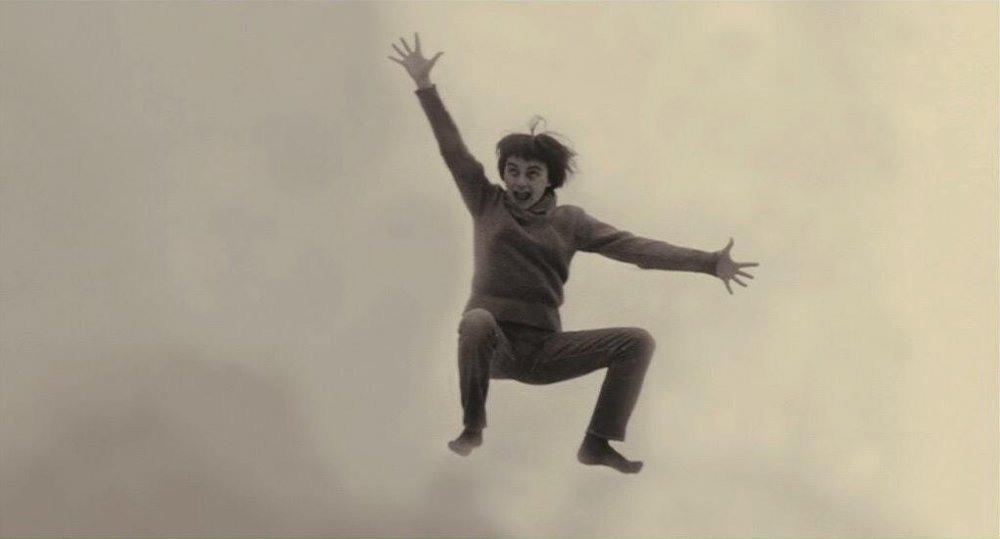
The Beaches of Agnès (2008)
“I play the role of a plump and chatty little old lady,” announces Agnès Varda in her “autobio-filmo-puzzlo self-portrait” The Beaches of Agnès (2008). It’s a disarming introduction from a distinguished figure in world cinema, but typical of Varda’s warm, playful tone, which is often generous to the point of self-parody and self-deprecation. Unlike certain famous cineastes who hide behind dark glasses and caps, Varda appears in many of her recent films, beaming towards the lens, walking backwards, whizzing through the Louvre in a wheelchair or ‘driving’ a cardboard car.
If Varda isn’t channelling her own inner child, she is pointing her camera at others. Children, including her own, appear frequently in her films. Likewise cats, a continuing and adorable obsession from 1954’s La Pointe Courte onwards. Aged 90, she is not precious enough to hide the ageing process: several inches of grey regrowth circle the top of her chestnut bowlcut and she directs her digital handheld camera to impertinent close-ups of the wrinkles and liver spots on the back of her hand.
Instead of retreating inside studios and editing suites, Varda goes out in the world, meeting people, gathering stories. She may dress up as a potato (for her Patatutopia show at the Venice Biennale in 2003), pose for selfies with fans or adopt larky postures on her charming Instagram account. If she’s not present in the flesh, she may substitute a mosaic, or a caricature, such as the triangular pipe-nosed portrait drawn by her friend Christophe Vallaux. Most recently, she charmed sectors of the world’s press who may have been unaware of her theories of cinécriture by sending full-size cut-outs of herself to the Oscar nominees’ luncheon, including one in which she is holding a beloved cat. Luminaries including Meryl Streep and Greta Gerwig appear as delighted by the cardboard Varda as they might be by the real deal.
Agnes Varda receives an Honorary Award at the 2017 AMPAS Governors Awards
The Beaches of Agnès encapsulates Varda’s frolicsome persona: although she discusses losses and struggles, she approaches her own life and work with an endearingly sunny surrealism. If everyone has a landscape inside them, she says, then she contains a beach. Amid reminiscences of childhood holidays and happy years in California, Varda addresses the audience from inside a giant whale on the sands, and builds a miniature shoreline in a busy street. The office staff of her production company Ciné-Tamaris decamp to the urban beach, film cans, phones, computers and all, absurdly completing their daily work with sand between their toes. Likewise, Faces Places sees her and artist JR crossing France with an oversized photo booth, redecorating the landscape around them to be a little more human, a little less mundane.
Varda’s joyful generosity reached its peak, perhaps, in The Gleaners and I (2000), a soft-hearted film about a serious topic. While travelling with her camera to meet people who choose to, or are forced to, forage their daily food, Varda contemplates the subject of gleaning, in art and society, while examining her own ageing self. Adapting to her wrinkled flesh and grey hair, she finds joy in damaged objects, such as a clock with no hands. From a pile of discarded potatoes, she chances upon a heart-shaped tuber, and collects all its likenesses. A follow-up film, shot two years later, reveals that fans still send her heart-shaped pommes de terres, and Varda is delighted by them, even as they turn purple, shrivel and sprout.
All of which is to say that Varda is playing the role well. A mistress of disguise, Varda coats her most serious messages in a sugar shell – like the gorgeous, pop-singer heroine of 1962’s Cléo from 5 to 7 contemplating her mortality in a feathered cap. As she said of her 1965 adultery drama Le Bonheur, saturated with primary colours and sunflowers: “I was trying to make the shape of the film so lovely and nice that if you don’t want to face what it means you don’t have to.” Even a heart-shaped potato will rot, a joyful feminist is still angry, and regardless of her humble self-presentation, Varda is a visionary artist who is always serious, even when she isn’t.
Multimedia artist
by Rebecca J. DeRoo
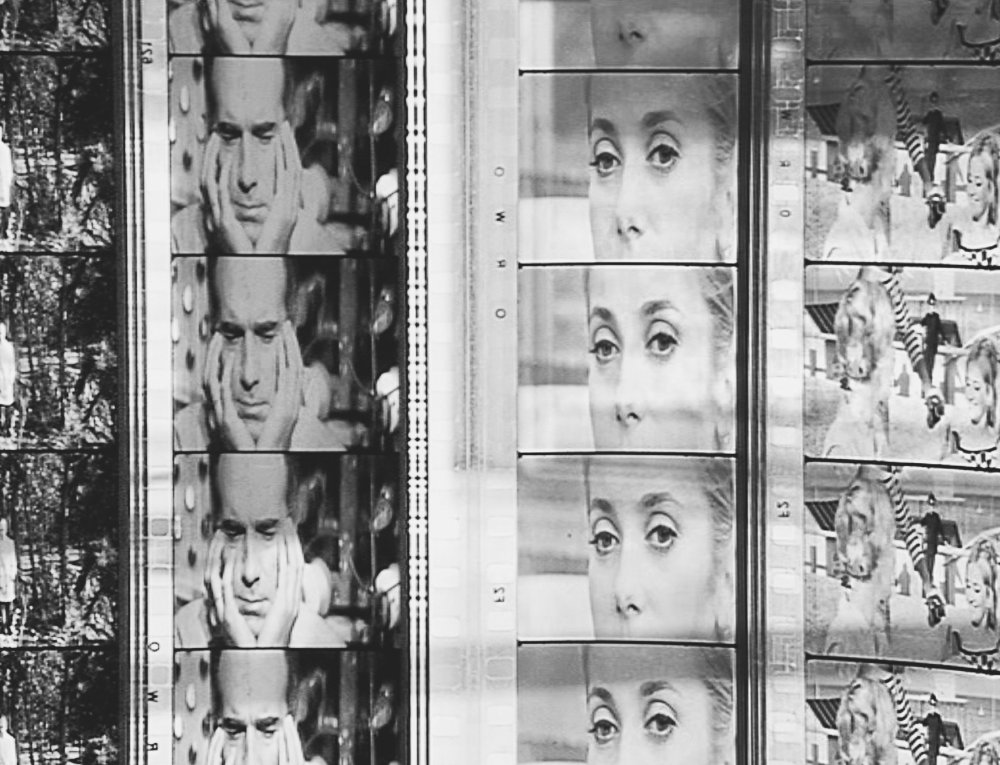
A spread of film stills from Agnès Varda’s 2012 book Les trois vies d’Agnès
Agnès Varda joked that at the beginning of the 21st century, when she was in her early 70s, she became a young visual artist. Audiences saw her visual artwork as new, as Varda had been primarily known as a filmmaker. Historically, critics praised her as the innovative ‘mother’ of the nouvelle vague, with her first film, La Pointe Courte (1954), a precursor to the movement, and Cléo from 5 to 7 (1962), made at its height. This identity has long overshadowed other parts of her career. More recently, scholars recognised her as an essential feminist filmmaker. At the same time, Varda continued to create new work, making films as well as multimedia art over the last two decades.
Yet Varda worked among various media across her career. Before she pursued cinema, she studied art history and practised photography, and her cinematic work reveals a rich knowledge of these traditions. A well-known filmic example is The Gleaners and I (2000), in which Varda includes 19th-century paintings of gleaners (depicting women walking the recently harvested fields gathering stray grains) as a metaphor for her own cinematic practice (travelling throughout France with her handheld digital camera, gleaning images for her documentary).
Less well known is that Varda has quietly yet subversively woven references to histories of art, photography, and film throughout her work, evoking among other visual traditions Renaissance painting in La Pointe Courte, documentary photography in Daguerréotypes (1975), and surrealist painting and photography in The Beaches of Agnès (2008). They form a sophisticated commentary on controversial issues, subtly broadening some of the most advanced aesthetic and political discourses of her times. Dialogue among media is a core characteristic of her work across the long trajectory of her prolific career.
In her final years Varda created films and artwork in various forms. Her magisterial installation at the Cartier Foundation in Paris, L’Ile et Elle (The Island and She, 2006), used different media to mediate her memories of the island of Noirmoutier, where she holidayed with her late husband, the director Jacques Demy.
She made one work literally out of film: My Cabana of Cinema has a metal roof and frame, and walls of celluloid film, the structure recalling seaside shacks or cabanas. The material was her own earlier cinematic work, Les Créatures (1966), which starred Michel Piccoli and Catherine Deneuve and was made on the island and dedicated to Demy. Varda originally referred to the structure as “My Cabana of Failure”, because she felt the film was commercially unsuccessful on its release – but here she recycled the film, giving it a new lease of life.
Varda sometimes called this work a way to “dwell in her house of cinema” – punning on the idea of an arthouse cinema, but also signalling that here she uses the medium differently – creating a three-dimensional house as artwork. Light penetrates the film, not through projection, but via ambient light in the gallery; we can see the materiality of 35mm film and its 24 frames per second.
Varda continued to realise major exhibitions, such as the one at the Los Angeles County Museum of Art, where she created artwork based on her late 1960s Los Angeles films, and at the CAFA Art Museum in Beijing, where she exhibited new installation art structures along with photographs she took in China in 1957.
Her latest installation work was one commissioned for last year’s Liverpool Biennial. With the working title of 3 Mouvements, the piece is a three-channel video installation that combines extracts from Vagabond (1985), Documenteur (1981) and The Gleaners and I. As is so clearly demonstrated in Agnès Varda from Here to There (2011), her five-part film and television series chronicling her conversations with other artists and activities in the art world, Varda’s artistic and cinematic pursuits nourish one another.
Le chat d’une poete
by So Mayer
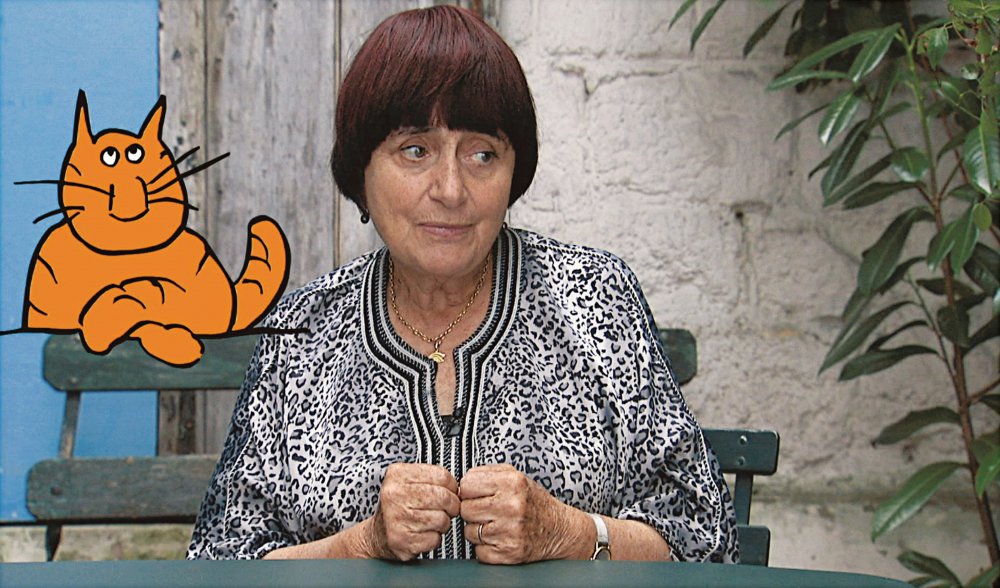
The Beaches of Agnès (2008)
In February 2018, Agnès Varda gave two Charles Eliot Norton Lectures at the Mahindra Humanities Center at Harvard, beginning her first lecture, The 7th Art and Me, with three words that she said describe her practice: ‘imagination’, ‘creation’ and ‘sharing’. Of the last, she noted, “I don’t make films for myself [but…] to have what is called feedback. I wonder,” she mused, “why is it not called feelback, because we want feelings to go through [the film] and be shared.”
For Varda viewers, such linguistic playfulness – often across more than one language, as here where she is punning in English – will be familiar; perhaps so familiar that it is undervalued despite her coining of cinécriture to describe her filmmaking. As the film historian Haden Guest, who invited Varda, told Harvard paper the Crimson, “She’s a poetess. One of the aspects of her work that is rarely spoken about is her skills as a writer.”
Varda only published one book: 1994’s Varda par Agnès is a memoir as catalogue raisonné, a project fusing the enumerative impulse of Roland Barthes’s A Lover’s Discourse and “l’imagination des matières” practised by Gaston Bachelard, whose lectures Varda attended at the Sorbonne in 1946-47 (although she was too shy to talk to him). Film scholar Sandy Flitterman-Lewis notes, in To Desire Differently (1990), that Varda was “particularly interested in this theory… in which certain personality traits were found to correspond to concrete elements in a kind of psychoanalysis of the material world.”
Varda by Agnès trailer
Here is one early entry in Varda’s book, addressing the imagination of a remembered object, like the radios and cars that so poignantly populate Jacquot de Nantes (1991):
“C commes Cahiers: Je les aimais, petite. Le désir qu’on en avait les choisissant. Leur odeur… Une anecdote de maman: Les bombes dégringolent sur Bruxells. C’est le 10 mai 1940, le début de la guerre. Il faut quitter la ville. Maman met en valises un minimum d’effets pour chacun… Je la regarde, elle emplit un carton avec du sucre, des crayons et une cinquantaine de cahiers neufs… Oserai-je me lancer à sauter des cahiers de maman aux Cahiers du cinéma?…”
(“C for cahiers [notebooks]: I loved them, when I was little. The desire when one got to choose them. Their smell… An anecdote about my mother: the bombs fall on Brussels. It’s 10 May, 1940, the start of the war. We must leave town. Mother packs the minimum of luggage for each person… I watch as she fills a box with sugar, pencils and 50 new notebooks… Dare I launch into a leap from my mother’s notebooks to Cahiers du cinéma?’)
Varda, écrivaine: here is her typically poetic thought process, from the new-book smell that excited a child who wanted to grow up to be an artist, to the cultural wave in which she would take part. There is also a modest suggestion of her identification with the small, everyday notebooks used by her mother over the cultural capital of the capitalised Cahiers du cinéma.
Varda’s films are not – unlike her mother’s cahiers – diaries, but they could be called scrapbooks: bricolages, with a trace of the influence of the French surrealists who crossed between artforms in order to realise the way materials are always imagining themselves as something else. Varda is not often called a surrealist, and yet: in Jane B. par Agnès V. (1987), Jane Birkin appears rampant as Joan of Arc, taking the place of a heroic male statue on a Paris quay, as Varda’s cat Zgougou will similarly replace a bronze lion in a later short. Voilà! Her fondness for magicians, for sleight of hand equal to her deflationary sleight of word and image, is evident in the café magician who introduces another punningly titled documentary: Daguerréotypes (1975).
Mur Murs trailer
Like the surrealists, Varda sometimes stages verbal puns visually, and vice versa. How can one translate the bilingually punning title of her 1981 documentary about murals, Mur Murs? Perhaps ‘whispers of walls’, the way a mural calls out to the passerby the secrets of the community it lives in. To such whispers, Varda’s ears attend and call the viewer to become fully an audience by doing the same. That associative, often punning logic shapes the voiceovers that frame both fiction features such as 1977’s One Sings, the Other Doesn’t (delivered by Varda herself) and 1981’s Documenteur (delivered by her collaborator, actor and filmmaker Delphine Seyrig) and her late documentaries.
It is still rare that a woman’s voice takes up the space of the voiceover; when Varda made Mur Murs and One Sings…, that was truer still. In Documenteur – whose title is a rich pun on documentaire and menteur (liar) – she muses on this absence of the female voice by casting the editor of Mur Murs, Sabine Mamou, as a film company secretary who finds herself delivering the voiceover… for a documentary about murals. Just as women have taken to the streets in her films since Silvia Monfort in La Pointe Courte (1954), so too they have been using their voices: Cléo is not the only singer; Pomme, backed by Groupe Orchidée, sings about women’s right to choose in One Sings, with lyrics by Varda that include a fitting (both thematically and metrically) quotation from Friedrich Engels.
Today there is an alleyway named Varda in Sète, where her family fled during World War II and where she shot La Pointe Courte. This seems highly appropriate: that a filmmaker whose play with language often increases the spaciousness within words should herself have become a place. The 21 cats that walked through her first film could now sun themselves on their great cine-poet’s cobbles.
Spaces places
by Adam Scovell
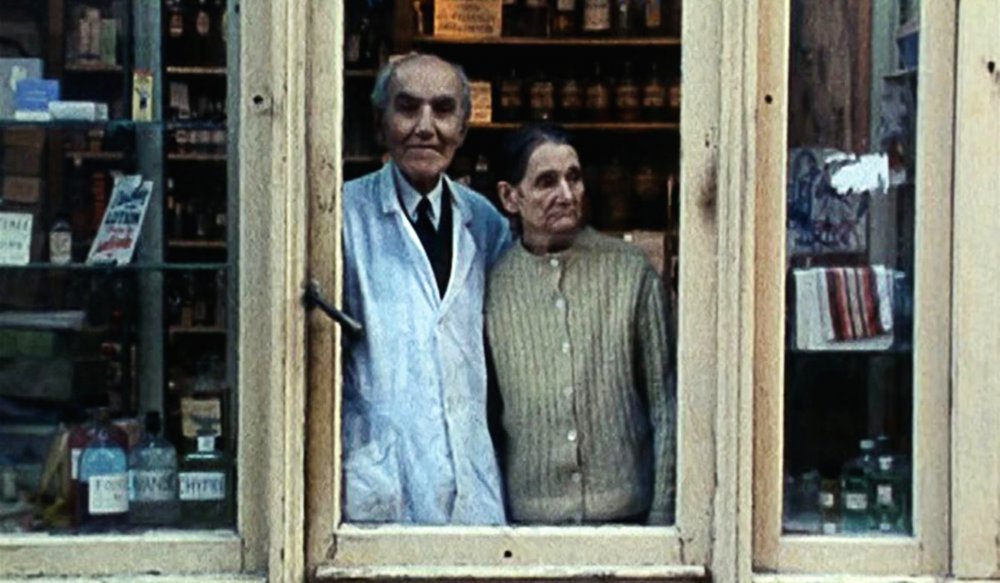
Daguerréotypes (1976)
Varda was a cinematic cartographer. She traveled widely to make her films, sometimes following her own paths of interest, as in documentaries such as The Gleaners and I (2000) and Faces Places; at other times following in the footsteps of wandering characters, such as Cléo (Corinne Marchand) in Cléo from 5 to 7 (1962) and Mona (Sandrine Bonnaire) in Vagabond (1985). A sense of place is incredibly important to her work, either as a fixed locale within which people live out their lives or as a constantly evolving backdrop which reflects a journeying momentum. If the characters in focus are static, the films tend to traverse the same places again and again, heightening their unusual essence via repetition. If the characters are itinerant, place constantly fluctuates, as unstable as the emotions of the walkers themselves.
In her documentary Daguerréotypes (1976), Varda concentrates on the lives of her neighbours in Montparnasse, zooming in on the very locality of her own street. The film pays enjoyably eccentric attention to seemingly random everyday moments, but its key significance lies in showing how people are embedded within a sense of place.
The same fixed setting can be found in her debut, La Pointe Courte (1954), which observes the fishing town of Sète in minute detail during a visit by its married protagonists. There’s a clear knowledge and affection for the place, expressed in vivid footage of real people from its streets. Varda’s apparent desire for authenticity, undoubtedly deriving from her time as a street photographer, sees her explore each place with passionate curiosity. Meandering through space, she maps it through time via her camera’s gaze. Detail is gleaned literally, gathered up as she passes, in much the same way as the collectors after the harvest in The Gleaners and I.
Agnes Varda & JR introduce Faces Places
Varda always links people and place, one explicitly defining the other, something recognised in the title of Faces Places. In it, with the help of artist JR, she explores the connection in the most overt of ways: people’s faces and bodies, including her own, are fixed to walls in the form of giant photographs. Eyes stare out as towns and buildings become personified. As a director, she had a rare understanding of the ineffable importance place holds over us all, a conveyor of our need for some fixed position in an ever-changing environment. An image of her toes is mischievously placed by JR on the side of a train in Faces Places. The landscape changes constantly but the person is now frozen in a continuous photographic moment.
But place is far from always being benign in Varda’s filmmaking. With her more settled characters, the stasis means her settings can create an uncomfortably jovial disjuncture. In Documenteur (1981), the melancholy of its lonely lead character, Emilie (Sabine Mamou), is almost mocked by the blazing summer of Californian beaches, while in Le Bonheur (1965), François (Jean-Claude Drouot) drifts from his marriage with such ease, it almost seems as inevitable and natural as the changing of the seasons around him. Following the death of François’s wife, the brutal replacement of her by his mistress sits in stark contrast to the gleaming yellow daffodils and beautiful summer landscapes. Place in this case parodies masculine privilege. And such gendered colouring of place is suffered by Varda’s other wanderers. In Vagabond, Mona struggles through the wintry landscape of Hérault, fighting with the land and its people until the place eventually destroys her, her body taken under the hoar-frost.
Even with all her globe-trotting, Varda still makes her way back to the house where she’s lived since the 1950s, just behind Montparnasse Cemetery in Paris where her late husband Jacques Demy is buried. That quaint building on rue Daguerre, with its painted walls and sauntering cats, is her ultimate place of return: home. Even wanderers as adventurous as Varda need somewhere finally to drift back to.
The visual stylist
by Isabel Stevens
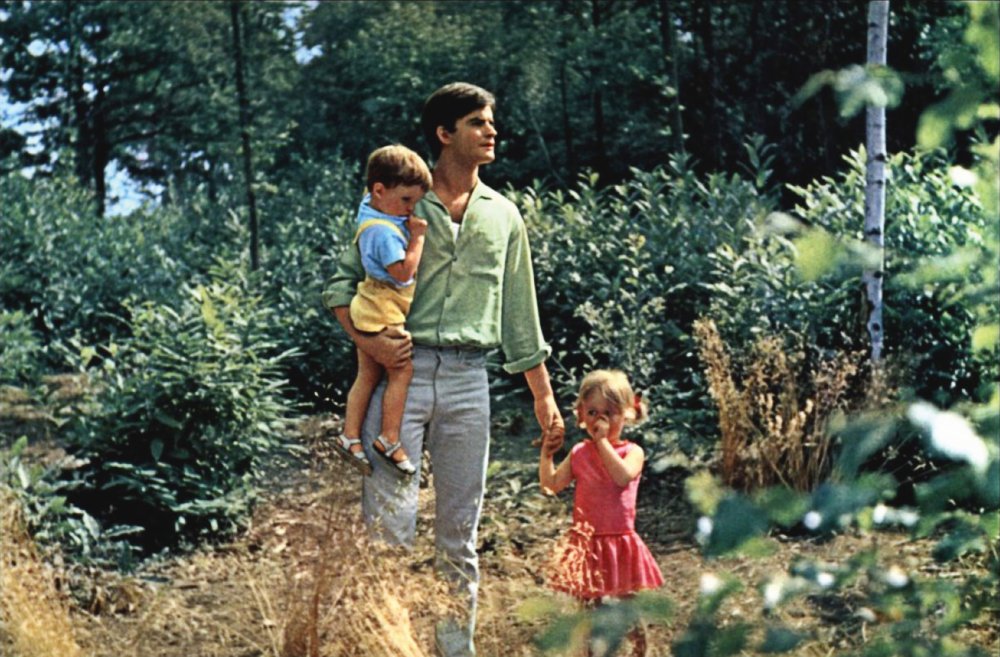
Le Bonheur (1965)
That Agnès Varda had visual verve was evident from her first foray into filmmaking in 1954: La Pointe Courte was clearly a photographer’s film. Varda’s first feature delights in the quiet spectacles of the fishing quarter of the Mediterranean village of Sète. The attention paid to objects, texture, light and shadow and Varda’s unexpected compositions all betrayed the filmmaker’s background as a prowling shutterbug with a love of landscape.
One year later, in O saisons, ô châteaux (1957), a short commissioned by the French Tourist Board, Varda’s signature was more flamboyant. In her idiosyncratic exploration of castles in the Loire region, models in colourful haute couture stroll along the ramparts, before Varda makes a characteristic digression, and follows the castle’s caretakers. Over the next six decades, Varda has never really stopped experimenting with style, whether in her films, her installations or with her own appearance.
Characterising her visual style, however, is not easy, as it constantly changes. Just as in O saisons, ô châteaux, clothing and landscape take a central role in many of her films: in Cléo from 5 to 7 (1962), the streets of Paris and singer Cléo’s appearance loom large. Meanwhile, in Vagabond (1985) the antithesis of Cléo in many ways – a homeless woman in muddy clothes roams the countryside. Tracking shots figure heavily in both films – as indeed in many of her others – as Varda gives the impression of walking along with her flâneuses; just another instance of realism and overt stylisation going hand in hand in her work.
Varda likes intertitles and formal tricksiness, as shown by the chapters of Cléo, and the pointing hands that direct us back and forward in time throughout Jacquot de Nantes (1991), her portrait of the early life of her husband Jacques Demy.
Colour is clearly important to her. Cléo starts with an abrupt jolt to monochrome after the colourful tarot cards credits sequence, as if to contrast Cléo’s seemingly perfect life, as seen from the outside, with her own experience of it. And famously, there’s Le Bonheur’s (1965) tale of marital infidelity sketched in vivid Eastmancolor, where happiness is interrogated in full glare.
One Sings, the Other Doesn’t trailer
Upending aesthetic expectations is one of Varda’s hallmarks. So her film about abortion, One Sings, the Other Doesn’t (1977), is an unusually optimistic tale – indeed, a musical! – with a soft lyrical bent. Later, with The Gleaners and I (2000), Varda embraced nascent digital technology that other filmmakers sniffed at and gleaned an overlooked charm from its lo-fi fuzziness. Fiercely independent, she has never had to compromise her vision in the way that other filmmakers, chasing bigger budgets, have had to do. How her films are presented to the outside world is another crucial factor – she made her own posters for Vagabond, fly-posters asking the question: “Have you seen this girl?” Artisanal is a good way to describe her style: she is a folk filmmaker at heart, as her new film Faces Places further confirms.
However, her audacious aesthetics haven’t always been appreciated. François Truffaut found La Pointe Courte “a little too framed”, while the critic Georges Charensol dismissed her visual choices in that film as “gratuitous”. Cléo’s visual flair was welcomed by more critics, but not Stanley Kauffmann of the New York Times, who dismissed Cléo as a “flashily dressed-up conventional tear jerker”.
The charge of frivolity was always more likely to haunt a female director, particularly one who in Cléo explores a so-called frivolous singer questioning her objectification. The endless mirrors and reflections in Cléo highlight a woman trying to discover her true identity (rather novel for 1960s cinema). What Kauffmann missed was that Cléo’s changing wardrobe shows how, as the film progresses, she gradually dresses to please herself.
Varda, with her purple and grey bob, has always dressed to please herself (not least with her potato outfit at the 2003 Venice Biennale). Now she is celebrated for her formal adventurousness, but for years her visual sensibility – easily dismissed as simply whimsical – was perhaps one reason she went under the radar as an auteur.
But for all her visual playfulness, Varda’s aesthetic quirks are underpinned with meaning. What would Le Bonheur be like with dampened hues? Not nearly so caustic, strange and claustrophobic. Or what if The Gleaners and I (2000) was a polished, orderly documentary? It’d be far poorer as a celebration of the imagination, and would lack that vital questioning of what is counted as cinematic.
-
Sight & Sound: the July 2018 issue
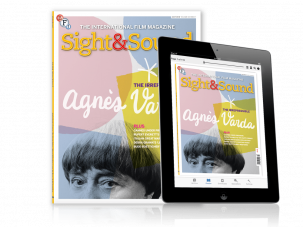
The irrepressible Agnès Varda, Cannes 2018, Marco Bellocchio, Debra Granik, The Happy Prince, Budd Boetticher and more.
-
The Digital Edition and Archive quick link
Log in here to your digital edition and archive subscription, take a look at the packages on offer and buy a subscription.




